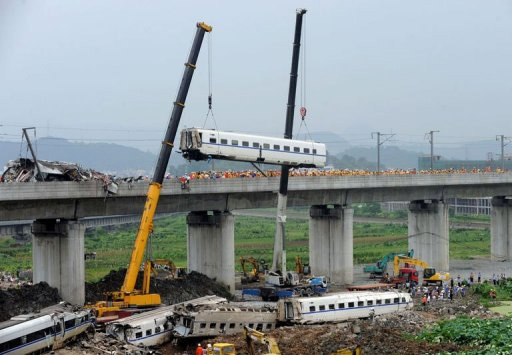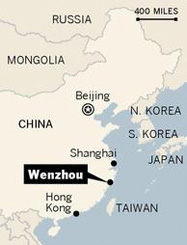Citizens Question Rail Safety after Train Wreck in Wenzhou, China

By Julia Gu
Jul. 25 – A rail accident has left at least 43 dead and more than 200 injured after two high-speed trains collided at approximately 8:27 p.m. on Saturday near the eastern Chinese city of Wenzhou in Zhejiang Province. The accident has intensified concern and criticism of the country’s powerful Ministry of Railways, which has come under fire this year after charges of corruption linked to shoddy construction and a string of issues relating to the recently opened Beijing-Shanghai high-speed rail line.
 After apparently being struck by lightning, the Fuzhou-bound high-speed train D3115 lost power and came to a halt on a bridge near Wenzhou on Saturday evening. The stranded train was then later struck violently from behind by high-speed train D301 on its way from Beijing to Fuzhou, sending four carriages from the oncoming train tumbling off the 30-meter-high viaduct. The two trains combined held more than 1,500 passengers.
After apparently being struck by lightning, the Fuzhou-bound high-speed train D3115 lost power and came to a halt on a bridge near Wenzhou on Saturday evening. The stranded train was then later struck violently from behind by high-speed train D301 on its way from Beijing to Fuzhou, sending four carriages from the oncoming train tumbling off the 30-meter-high viaduct. The two trains combined held more than 1,500 passengers.
Authorities moved quickly to take charge of the situation with Chinese President Hu Jintao and Premier Wen Jiabao announcing that rescue efforts were the first priority and the Railway Ministry organizing related departments to do everything they could to save lives. An emergency overhaul of safety measures across the country’s rail network was also ordered.
In the aftermath, the Railway Ministry announced that the head of the Shanghai Railway Bureau Long Jing, the bureau’s Communist Party Chief Li Jia, and deputy chief of the bureau He Shengli were relieved of their duties.
Despite this announcement, officials haven’t been able to calm angry Chinese netizens who are questioning the safety of the national high-speed railway system. The main question, why railway signals did not stop the second train, has not been answered. What is especially worrisome is that this is not the first time officials have blamed weather conditions for delays and breakdowns in its high-speed rail network. On July 10, a train traveling on the Beijing-Shanghai high-speed route broke down near Suzhou in Anhui Province after an equipment failure triggered by high winds and thunderstorms.
Over the last few days, news and videos on the internet showing rescuers burying parts of the wrecked trains at the site have irritated netizens as well as residents along the railway. Many were left wondering how the equipment could be checked and evaluated so quickly while others were worried that there might still be individuals in the train carriages. According to reports, it was the Railway Ministry that gave orders to clean up the ground under the elevated viaduct.
At 4:00 a.m on Sunday the Railway Ministry claimed there was no sign of life on the carriages and that rescue work had stopped a few hours earlier. Despite this, one survivor was found at 5:00 a.m. and, at 7:00 a.m., state media again claimed that there were no survivors as cranes began moving the fallen carriages. Much later, at 5:20 p.m. on Sunday, rescuers found a four-year-old girl alive in one of the fallen carriages.
During a press conference on Sunday night at 10:30 p.m., Railway Ministry Spokesman Wang Yongping described finding the young girl as a “miracle.” Angry internet users on the Chinese microblogging web site Weibo have been calling the spokesman, “Mr. Miracle.”
Also during the press conference, Wang made apologies and expressed his condolences towards the passengers and their families. He said the ministry would conduct investigations and “learn from their mistakes” to prevent similar accidents. When reporters asked him about the burying of the wrecked cars, he answered “we made this decision in order to better investigate the site. As you can see, there’s a huge mud puddle under the elevated rails. The second reason is that the rails should be cleaned up as soon as possible so that our railway system can recover.”
Outraged reporters bombarded the spokesman with critical questions such as compensation for the victims, to which Wang said that compensation would be around RMB170,000 (US$26,284). There were five foreigners involved in the rail accident: two of whom died and two who were injured and whose condition was unknown, according to local reports.
The deadly accident has ignited public dissatisfaction over safety in China. Most internet users complained they can’t trust the quality of many things in the country now – including food, beverages, and infrastructure – and that the government doesn’t do enough to conduct qualified monitoring.
The train crash was one of several recent traffic accidents across the country. Last Friday, 41 people were killed when an overloaded bus caught fire in central Henan Province. Earlier this month, an escalator at a subway station in Beijing collapsed, killing one boy and injuring 28 people. From July 11 to July 15, three bridges collapsed in separate incidents in southern China.
Some business analysts say that the series of recent infrastructure-related accidents show glaring flaws in the development of China, quoting the Chinese proverb, “Haste does not bring success (欲速则不达).”
“China, please stop your flying pace, wait for your people, wait for your soul, wait for you morality, wait for your conscience! Don’t let trains derail, don’t let the bridges collapse, don’t let the roads become traps, don’t let houses become ruins. Slow down, allowing every life to have freedom and dignity. No one should be left behind by our era. Everyone should reach their destinations safely,” wrote Tang Dahuan, a journalist based in Beijing.
Related Reading
China May Scale Back Investment in Strategic Industries
China’s Beijing-Shanghai High-speed Rail Breaks Down, Again
Food Safety in China a Multi-Source Problem
- Previous Article Shenzhen Announces Public Holidays for Universiade
- Next Article Beijing Looks to Hike Average Wages









